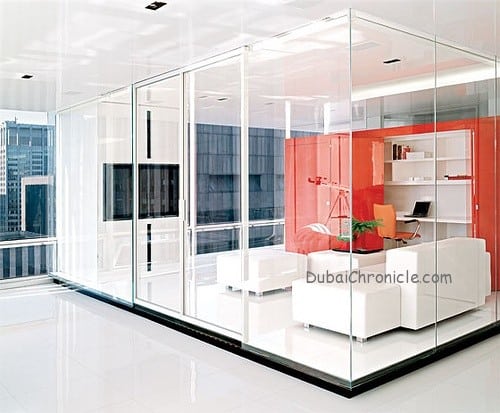
There was no significant change in Dubai office rents recorded in Q4 2013, according to the fourth quarter of 2013 Dubai Real Estate Overview report by Jones Lang LaSalle. While office rents increased marginally only in some prime buildings, they remained unchanged or dropped slightly elsewhere as landlords competed to attract occupiers seeking to sign deals ahead of their year-end. The positive vibe surrounding the World Expo 2020 win did not impact office rents and is unlikely to affect the office market significantly in 2014.
The top open-market rent* in the DIFC remained unchanged in Q4 at AED 2,610 per sq m, while it improved marginally (less than 2%) to AED 1,850 per sq m elsewhere in the CBD.
The average quoting office rent across the broader market remained unchanged at AED1,390 per sq m in Q4 2013.
The office market in Dubai continues to see a “flight-to-quality”, with the best performing locations being DIFC, Burj Downtown and TECOM A&B. Rental values in secondary locations remain under downward pressure. This two tier market is also evident within individual locations such as Business bay and JLT. Prime rents (those for the best building) in Business Bay have improved by 21% Y-o-Y and 5% Q-o-Q. However, not all the commercial buildings in the area have seen such increases. Towers overlooking SZR, in proximity to the metro station and those with single ownership seem to be more popular.
Prime rents in JLT remained stable in the last quarter, having witnessed a dramatic 75% increase Y-o-Y rise but once again this increase has been limited to the best quality buildings that have been able to capitalise on JLT’s metro access and free zone status.2014 is expected to see a continuation of the two-tier office market in Dubai, with prime locations improving and secondary areas remaining under downward pressure. The strong supply pipeline will continue to apply a natural break to potential rental growth.
The total office stock within areas monitored by JLL at the end of 2013 stood at 7.3 million sq m. The last quarter of the year saw the completions of more than 32,500 sq m of office space, with the Opal Tower and the Oxford Tower, both in Business Bay, being the main completions.
The total office space delivered in 2013 stood at 390,000 sq m, 34% less than the completions in 2012. Like in the previous years, a number of projects have been delayed at the final completion stage. While there is a total of more than 850,000 sq m of additional office space that could be completed 2014, in reality the supply pipeline is likely to be significantly lower.
The CBD (DIFC, Burj Downtown and SZR) currently accounts for around 19% of the existing office stock. The fastest growing area is Business Bay, which accounts for almost 50% of the future supply expected over the next 3 years. According to developers, around 1.4 million sq m of additional office space could enter the market by 2016. Eagerly awaited projects include Central Park in DIFC, DTCD at the Dubai World Trade Centre, Jumeirah Business Center 6 in JLT, and the Dubai Design District by TECOM.
Almost half of the proposed upcoming office supply (2014 – 2016) is located in Business Bay, with major completions including Tamani Art Offices, Bay Square by Dubai Properties, Capital Bay and Park Central by DAMAC and Bay View. Other areas proposed to witness significant completions by 2016 include DIFC, and JLT, along with two new emerging areas, the Dubai Design District and Dubai World Central.
Office demand
The last quarter of the year typically sees a seasonal increase in take-up in the Dubai office market, as tenants seek to close deals ahead of their year end. 2013 was no exception with a significant increase in leasing activity recorded in the final quarter of the year.
A continuing trend remains the “flight to quality”, with a number of companies relocating from older buildings and secondary locations towards prime areas and higher quality buildings.
Another aspect of this trend has been for companies to consolidate their operations in one location. However there were few examples of this consolidation trend during Q4 2013.
Companies continue to focus on optimising efficiency by redesigning office layouts and accommodating more people in less space.
Single ownership buildings continue to account for the majority of demand, while strata projects remain less popular, especially amongst large global companies. Two aspects of location are becoming increasingly important to occupiers, proximity to a metro station and the availability of car parking. Most of the demand in Business Bay is concentrated on those buildings facing SZR, especially those close to the metro station.
Landlords remain more bullish in the most prime locations, being less flexible on rents or willing to offer rent-free periods. Landlords in secondary locations however remain flexible as they continue to struggle to attract tenants.
Vacancy rates within the CBD have decreased slightly to 29% by year-end with a number of deals closing in the last quarter as corporates sought new space to align with their business strategies.
Securing Expo 2020 has had no immediate impact on demand for office space in Dubai. While the office sector is likely to benefit from the overall increase in economic activity generated by winning Expo 2020, it remains unlikely that Expo will generate significant additional for office space in the short term.























![The Square at Nad Al Sheba Gardens Now Open hope tax season treated you well! Just checking in—ready to refocus on growing your business? I remember how we discussed scaling your [specific aspect of their business, e.g., online presence] but paused due to time constraints. We now offer a streamlined 6-month plan that delivers real results without adding to your workload. Let me know if you'd like to chat—I’d love to help you pick up where we left off!](https://www.dubaichronicle.com/wp-content/uploads/2024/11/The-Square-5-218x150.jpg)








